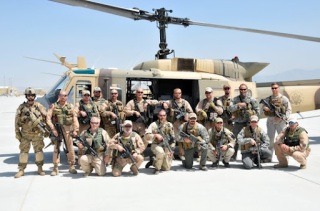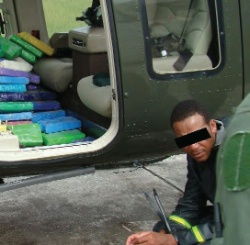Archive
What If Drugs Were Legal?
Africa: The New Mexico?
Mexico became the centre of cocaine trafficking only relatively recently. Before that, drugs were smuggled directly from Colombia to Florida. Once this became heavily policed the US’s hunger for cocaine obviously didn’t cease, so traffickers kept up supply by finding alternative routes, the main being the Mexico/US border.
Once cocaine was travelling through the country, not all of it made it to its customers in the US, creating the aforementioned ‘spill over markets’. As criminal gangs saw the financial potential in controlling the flow of drugs through their country, highly organized cartels emerged: bribing officials, murdering rivals and even pushing to control production of the drugs.
The Mexican drug war, at its core, is about two numbers: 48,000 and 39 billion.The Mexican government updated its drug war death toll on Wednesday, reporting that 47,515 people had been killed in drug-related violence since President Felipe Calderón began a military assault on criminal cartels in late 2006. Many of these being innocents caught in the cross fire, civilians live in fear, as the beheaded bodies of whistle-blowers hang from bridges, and naked, dismembered torsos are chucked onto the side of the road.
Drug use and trafficking is on the increase in Africa. What should be emphasised is the damage produced by the actual drug laws, this is what needs to be scrutinised and looked at from a new perspective.
Reports indicate that the amount of heroin in Africa is increasing dramatically. Seizures of the drug increased from 159kg in 2009 to 234kg in 2010 in Egypt, 8.5kg to 35kg in Kenya, and 104kg to 202kg in Nigeria. The presence of smuggled heroin in Africa is mirrored with the drugs increased use, particularly in Mauritius, Tanzania and the Seychelles.
Seizures of cocaine also increased, with the levels in East Africa increasing four-fold between 2005 & 2010. Although the data are scarce, it is anticipated that this had lead to an increase in use of the drug, particularly in countries where the economy is on the up.
Why did hard drugs such as cocaine and heroin start to arrive in Africa in the first place? The most likely explanation is that when policing on usual drug trafficking routes became too heavy, smugglers discovered the alternative method of taking the drugs through Africa. These drugs were of course destined for Europe: a continent with a near insatiable desire for both heroin and cocaine. The adoption of new trafficking routes has created what is described as ‘spill over markets’, with countries not
deemed as the final destination for a drug starting to create demand for it themselves.
However, the drugs are not what should be emphasised. The main concern with this increased trafficking and use is that parts of Africa will start to resemble Mexico; that is to say, turn into war-torn areas with cartels fighting for dominance over smuggling routes; pump millions into the pockets of criminals; and have local and national laws undermined by the lure of corruption and the power of avaricious politicians.
These consequences are effects of the way that drugs are controlled as opposed to the drugs themselves. The attempt to quell the supply of cocaine in the US and subsequent lack of dip in demand caused the alternative routes to be developed once the originals had been constricted, and the drugs’ illegality perpetuated the crime and violence that surrounds them. All signs indicate that a similar situation will arise in areas of Africa, with traffickers continuing to push heroin and cocaine into Europe.
Three options are available: dramatically reduce, if not extinguish, Europe’s demand for cocaine and heroin; focus policing efforts on these new trafficking routes; or take the control of the drugs out of the hands of criminals via a form of legalisation and regulation.
The first option is not plausible, or at least cannot be addressed here. Humans have taken drugs for thousands of years, and it seems that they will continue to do so. 250million people took an illicit substance last year, continuing the steady year-by-year increase.
Focusing law enforcement on these new routes seems futile. Traffickers are intelligent, resourceful and most importantly adaptive. In a similar vein to the ‘balloon effect’; the phenomenon of when pressure is put on drug production in one area, it expands in another, pressure on one trafficking route will simply send more drugs through another.
It is only the final option that seems to show any promise. In fact, this is the one that many South and Central American countries are now calling for. It is predicted that allowing the state to control the production and sale of drugs would dramatically decrease the violent side effects of keeping such substances in a state of illegality. If customers could get their product from a trusted and reliable source, they would have no need to purchase it from criminals. Indeed, who buys illegal moonshine when you can buy a reputable brand?
It is crucial that our drug laws do not create another Mexico, whether it be in Kenya, Uganda, Tanzania, Nigeria, Egypt, Morocco; or all of these. The results would shatter Africa, perhaps in an even worse fashion than that of Mexico. Just as the continent is starting to boom economically, a crisis like this will reverse its nations’ development.
Drug cartels Using Subs in West Africa
Drugs traffickers for whom West Africa is a handy transit point between Latin America and Europe are becoming increasingly sophisticated in their attempts to avoid law enforcers says a United Nations anti-narcotics official Drug traffickers are turning to subs and other methods to avoid detection as they ship ever-greater quantities of cocaine via West Africa from the production fields of South America to the markets of Europe.
“We are not talking about military vessels here, but rather smaller ones which can be bought freely on the international market by anybody who has a couple of million dollars to spare,” said Alexandre Schmidt, regional head of the UN Office on Drugs and Crime (UNODC).He was speaking during a drugs summit dubbed the West Africa Coast
Initiative held in Senegal this week.
According to UNODC figures, based on seizures, 35 tons of cocaine were transited through West Africa in 2009, down from 47 tons the previous year. But Schmidt warned that the apparent fall in volumes could be down to the cartels’ improved capacity for hiding their activities.
It is estimated that the value of the trade through West Africa was now $800 million a year and rising. Schmidt warned that drugs cartels were threatening to turn West Africa into another Mexico, a country that has become a byword for drug-related violence. “What we are seeing in West Africa is like what we saw in Mexico,” he said.
West Africa is a largely poor part of the world and the value of the illegal drugs moving through the region dwarfs some national economies.He added that cases of local cocaine use were also on the rise and it was becoming, “a huge issue for public health” in West Africa.
Drug Trafficking Rising in Central Africa
In Cameroon, officials with the International Criminal Police Organization,Interpol, blame a surge in the drug trade on an an ongoing crackdown on traffickers in neighbouring West Africa.
Lawrence Tang Enow, an Interpol Regional Training Officer and a Senior Cameroonian Police Superintendent, said, “A few decades or years ago, it was zero. After some time, we started seizing a few grams. Now we got to a situation where, last year, we seized 140 kilograms.”
Those figures are for Cameroon alone. He said intelligence reports based on border police and customs data across the sub-region show increasing quantities of Europe-bound cocaine, as well as more frequent arrests of dealers and suspects.
According to the sub-regional branch of Interpol, the South American cartels and local allies are exploiting institutional and structural weaknesses to turn Central Africa into a transit hub on their “cocaine route” to Europe. They are able to take advantage of poor policing at ports and outdated traveller and cargo inspection equipment, porous land and sea borders, as well as corruption within security and customs institutions.
In February, the UN Office on Drugs and Crime, UNODC, estimated that cocaine smuggling in West and Central Africa generates some 900 million USD annually, up from 800 million in 2009.
Elsewhere, the US Drug Enforcement Administration, DEA, said in a report published last year that new players, including the Maghreb branch of al-Qaida [AQMI] and Nigeria’s Islamic terrorist group, Boko Haram, were getting increasingly involved in cocaine trafficking to raise money for their activities, or were being bankrolled by the traffickers for support.
According to Interpol officials, such connections set an even more dangerous precedent for the sub-region. Conrad Atefor Ntsefor, a police commissioner with the Interpol Central Africa Sub-regional Bureau in Yaounde, said “When they come in, they influence the politics of countries, they influence criminal activities, [and promote] corruption, and it’s a serious problem.”
The US Drug Enforcement Agency states that the money generated by underworld organizations sometimes outstrips the state budgets of some African countries, and is easily used to buy off government officials.
“If you know what it means in terms of money; it is a lot,” said Ntsefor. “So the fear is that if we don’t act and act in time, this phenomenon will become a very serious cankerworm.”
Interpol additionally warns that the region risks surges in piracy off its coasts, illegal arms circulation, human trafficking and general instability as a result of the traffickers’ invasion. It is currently forming partnerships with the police and customs departments of various countries. Together they will work to coordinate intervention strategies and update databases on the movements and activities of suspects. Interpol is also encouraging prompt information-sharing to facilitate the hunt for traffickers.
Commissioner Ntsefor says that, gradually, the efforts are paying off.
“When we [learn] how the operations in various countries work,” he said, “we share that intelligence and better coordinate through our secure communications systems. I must admit that is what has been the driving force for the arrest of drug traffickers.”
The effort adds to sporadic crackdowns being organized simultaneously across West and Central Africa and Latin America by the World Customs Organization, UNODC and Interpol. Between November and December 2011, one of the joint operations conducted in 25 airports in West-Central Africa and Brazil led to the arrest of over 50 suspects, the seizure of over 500 kg of cocaine, heroin, amphetamines, guns, counterfeit medicines, ivory and over 3.2 million dollars in cash.
Experts say replicating such clampdowns will ultimately discourage the traffickers.






